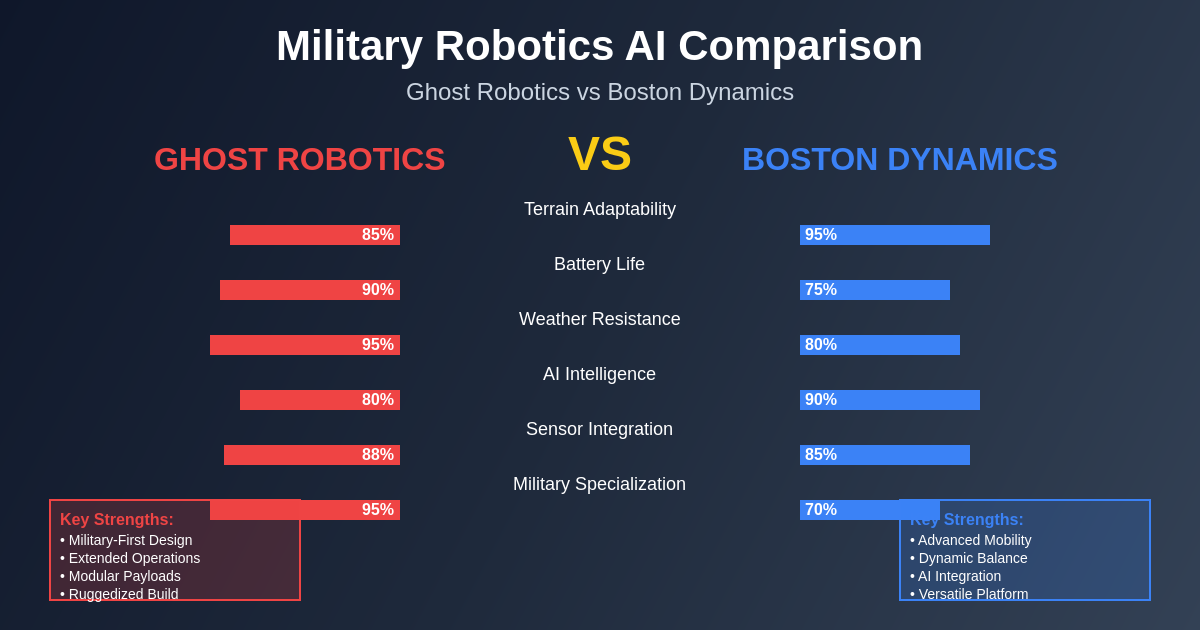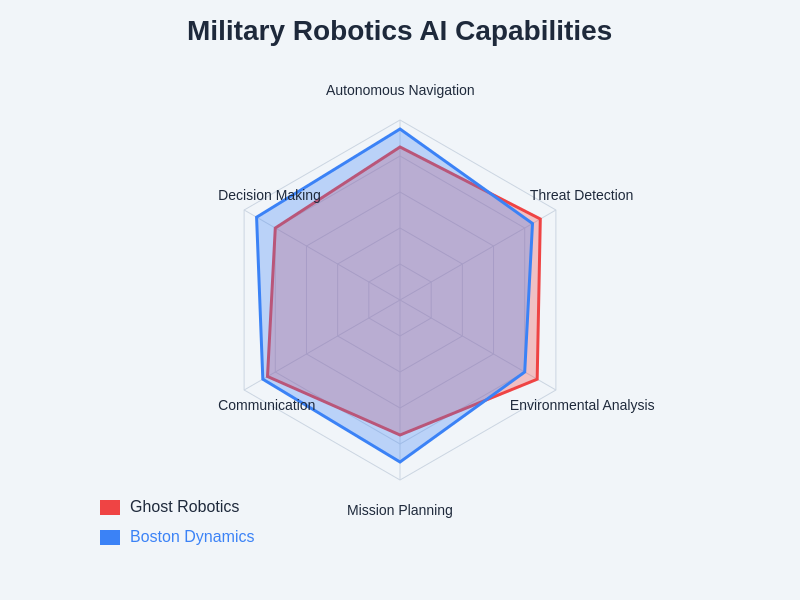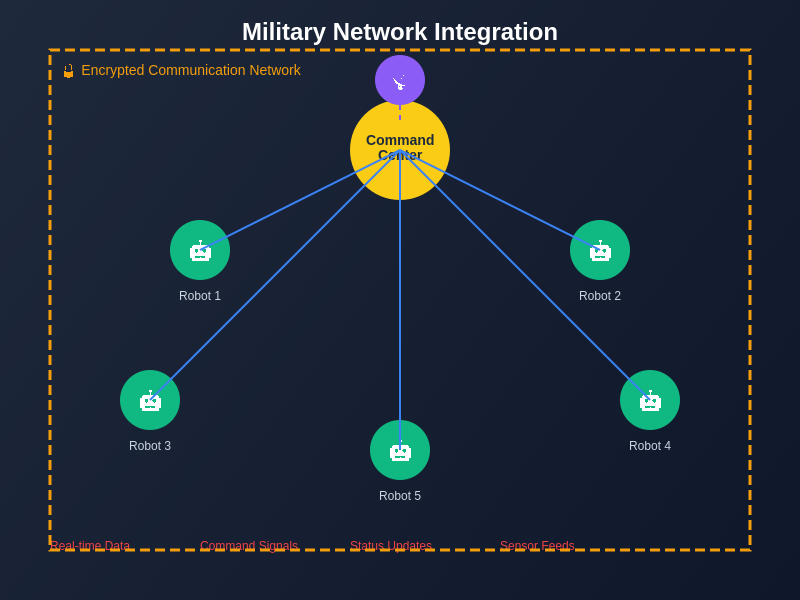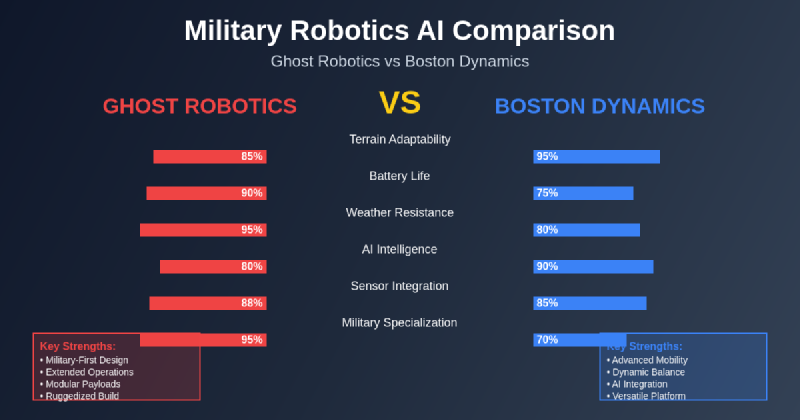The evolution of artificial intelligence in military and defense applications has reached a pivotal moment where autonomous robotics systems are transforming how nations approach security, surveillance, and defensive operations. Two companies have emerged as leading pioneers in this critical technological domain: Ghost Robotics and Boston Dynamics, each offering distinct approaches to military-grade robotic solutions that serve primarily defensive and security purposes.
Explore the latest developments in AI defense technology to understand how these innovations are reshaping security protocols and defensive strategies. The integration of sophisticated AI systems into robotic platforms represents a fundamental shift in how military and security organizations approach perimeter defense, reconnaissance, and threat assessment operations.
Understanding Military Robotics AI Applications
Military robotics AI serves primarily defensive and security purposes, focusing on protecting personnel, assets, and infrastructure through advanced surveillance, reconnaissance, and threat detection capabilities. These systems are designed to operate in hazardous environments where human presence would pose significant risks, providing critical intelligence and early warning capabilities that enhance overall security posture.
The applications of military robotics AI span multiple defensive domains, including border security, facility protection, explosive ordnance disposal, search and rescue operations, and environmental monitoring. These technologies enable military and security forces to maintain situational awareness, respond to threats more effectively, and protect human lives in dangerous situations.
Ghost Robotics: Specialized Defense Solutions
Ghost Robotics has established itself as a specialized provider of quadrupedal robotic systems designed specifically for military and security applications. The company’s flagship platforms, including the Vision series and Q-UGVs (Quadrupedal Unmanned Ground Vehicles), are engineered to operate in challenging terrains and adverse conditions that would be difficult or dangerous for human personnel to navigate.
The Ghost Robotics approach emphasizes modularity and mission-specific customization, allowing military organizations to configure their robotic systems with various sensor packages, communication equipment, and defensive countermeasures. This flexibility enables the platforms to serve multiple roles within a single deployment, from perimeter surveillance to reconnaissance missions and threat assessment operations.

The technical specifications and operational capabilities of Ghost Robotics systems reflect a deep understanding of military requirements and operational environments. Their platforms feature advanced locomotion algorithms, robust environmental protection, and integrated AI systems that enable autonomous navigation and threat detection in complex scenarios.
Boston Dynamics: Advanced Mobility and Intelligence
Boston Dynamics brings to the defense sector decades of experience in developing sophisticated robotic systems with exceptional mobility and intelligence capabilities. Their military-focused platforms, including specialized variants of Spot and other advanced robotic systems, demonstrate remarkable agility and adaptability in diverse operational environments.
The Boston Dynamics approach to military robotics emphasizes advanced artificial intelligence, superior mobility, and seamless integration with existing military systems and protocols. Their platforms are designed to work alongside human personnel, providing enhanced capabilities while maintaining the flexibility to operate autonomously when necessary.
Discover advanced AI capabilities for security applications that complement robotic systems in creating comprehensive defense solutions. The integration of multiple AI technologies creates layered security approaches that significantly enhance threat detection and response capabilities.
Technical Capabilities Comparison
The technical capabilities of Ghost Robotics and Boston Dynamics platforms reveal distinct approaches to solving military robotics challenges. Ghost Robotics focuses on ruggedized, mission-specific designs that prioritize reliability and operational effectiveness in harsh environments. Their systems feature extended battery life, weatherproof construction, and modular sensor integration that supports long-duration surveillance and reconnaissance missions.
Boston Dynamics platforms showcase superior mobility and dynamic movement capabilities, with advanced AI systems that enable complex navigation through urban environments, building interiors, and challenging terrain. Their robotic systems demonstrate exceptional balance, obstacle avoidance, and adaptive behavior that makes them particularly effective for search and rescue operations and facility security applications.
AI Integration and Autonomous Operations
The artificial intelligence systems integrated into both Ghost Robotics and Boston Dynamics platforms represent cutting-edge developments in autonomous robotics. These AI systems enable the robots to make intelligent decisions, adapt to changing environments, and execute complex missions with minimal human intervention.
Ghost Robotics AI systems are optimized for security and surveillance applications, featuring advanced computer vision, pattern recognition, and threat assessment algorithms. Their platforms can identify and track potential security threats, monitor large areas autonomously, and provide real-time intelligence to command centers and security personnel.
Boston Dynamics AI integration focuses on dynamic adaptation and complex problem-solving, enabling their robotic systems to navigate unpredictable environments, interact with various objects and obstacles, and execute sophisticated maneuvers that support diverse military and security missions.

Sensor Integration and Intelligence Gathering
Both companies have developed sophisticated sensor integration capabilities that transform their robotic platforms into comprehensive intelligence gathering systems. These sensor packages include thermal imaging, LiDAR, radar, acoustic detection, and chemical sensing capabilities that provide multi-dimensional situational awareness.
Ghost Robotics platforms excel in perimeter security and area surveillance applications, with sensor configurations optimized for detecting and tracking potential threats across large areas. Their systems can operate continuously for extended periods, providing persistent surveillance capabilities that significantly enhance security operations.
Boston Dynamics platforms offer exceptional versatility in sensor deployment, with the ability to carry and operate diverse sensor packages that support various mission requirements. Their superior mobility enables access to areas and vantage points that would be impossible for stationary surveillance systems or human personnel to reach safely.
Defensive Applications and Security Use Cases
The defensive applications of military robotics AI systems encompass a wide range of security and protection scenarios. Perimeter defense represents one of the most critical applications, where robotic systems patrol borders, facility boundaries, and sensitive areas to detect and deter potential intrusions.
Explosive ordnance disposal operations benefit significantly from robotic systems that can approach and investigate suspicious objects without risking human lives. Both Ghost Robotics and Boston Dynamics platforms can be equipped with specialized tools and sensors for identifying and neutralizing explosive threats safely.
Enhance your research capabilities with Perplexity for comprehensive analysis of defense technologies and security applications. Access to detailed technical information and comparative analysis supports informed decision-making in security technology procurement and deployment.
Environmental Monitoring and Hazard Detection
Military robotics AI systems provide exceptional capabilities for environmental monitoring and hazard detection in areas where human presence would be dangerous or impractical. These applications include chemical spill response, radiation monitoring, biological threat detection, and disaster assessment operations.
The autonomous nature of these robotic systems enables continuous monitoring of potentially hazardous areas, providing real-time data and alerts that support rapid response and threat mitigation efforts. Their ability to operate in extreme environments makes them invaluable for maintaining security and safety in challenging conditions.
Communication and Network Integration
Modern military robotics systems require sophisticated communication capabilities to integrate effectively with existing military networks and command structures. Both Ghost Robotics and Boston Dynamics platforms feature advanced communication systems that support real-time data transmission, remote operation, and coordination with multiple robotic units.
The network integration capabilities of these systems enable them to function as nodes in larger security networks, sharing intelligence and coordinating responses with other robotic systems, surveillance networks, and human operators. This interconnected approach creates comprehensive security ecosystems that provide enhanced situational awareness and response capabilities.

Training and Human-Robot Collaboration
The successful deployment of military robotics AI systems requires comprehensive training programs that prepare personnel for effective human-robot collaboration. Both companies provide extensive training and support services that enable military organizations to maximize the effectiveness of their robotic systems.
Human-robot collaboration in military applications focuses on leveraging the unique capabilities of both humans and machines to create more effective security and defense operations. Robotic systems handle dangerous, repetitive, or physically demanding tasks, while human operators provide strategic oversight, decision-making, and complex problem-solving capabilities.
Cost-Effectiveness and Operational Efficiency
The economic considerations of military robotics deployment encompass initial acquisition costs, operational expenses, maintenance requirements, and long-term value creation. Both Ghost Robotics and Boston Dynamics offer different value propositions based on their technical approaches and target applications.
Ghost Robotics platforms are designed for cost-effective deployment in specific military and security applications, with emphasis on reliability, durability, and operational efficiency. Their systems provide excellent return on investment for organizations focused on perimeter security and surveillance operations.
Boston Dynamics platforms offer premium capabilities and advanced features that justify higher initial investments for applications requiring exceptional mobility, intelligence, and adaptability. Their systems provide significant value for complex missions and specialized applications where standard robotic systems would be inadequate.
Future Developments and Technological Evolution
The future of military robotics AI promises continued advancement in autonomy, intelligence, and operational capabilities. Both Ghost Robotics and Boston Dynamics are actively developing next-generation systems that will provide enhanced performance, improved efficiency, and expanded application possibilities.
Emerging technologies such as advanced machine learning, improved battery technology, enhanced sensor capabilities, and better communication systems will continue to enhance the effectiveness and versatility of military robotics platforms. These developments will expand the range of defensive applications and improve the overall value proposition of robotic security systems.
Ethical Considerations and Responsible Development
The development and deployment of military robotics AI systems must be guided by ethical principles that prioritize human safety, security, and responsible use of technology. Both companies emphasize the defensive and protective nature of their systems, focusing on applications that enhance security while minimizing risks to civilian populations.
Responsible development practices include comprehensive testing, transparent capabilities documentation, appropriate use guidelines, and ongoing evaluation of ethical implications. The focus on defensive applications ensures that these technologies contribute to security and stability rather than creating new risks or conflicts.
Integration Challenges and Solutions
The integration of military robotics AI systems into existing military infrastructure presents various technical and operational challenges. These challenges include compatibility with existing communication systems, training requirements for personnel, maintenance and support considerations, and adaptation of operational procedures.
Both Ghost Robotics and Boston Dynamics provide comprehensive integration support that addresses these challenges through customized solutions, training programs, technical support, and ongoing system optimization. Their experience in military deployments enables them to anticipate and resolve integration challenges effectively.
Performance Metrics and Evaluation Criteria
The evaluation of military robotics AI systems requires comprehensive performance metrics that assess operational effectiveness, reliability, cost-effectiveness, and mission success rates. Key evaluation criteria include system availability, mission completion rates, maintenance requirements, and integration effectiveness with existing security systems.
Performance evaluation also considers environmental resilience, battery life, communication reliability, and the accuracy of AI-driven decision-making systems. These metrics provide objective measures for comparing different robotic platforms and optimizing their deployment for specific security applications.
The continuous evolution of military robotics AI represents a fundamental shift in how defense organizations approach security, surveillance, and threat response operations. Ghost Robotics and Boston Dynamics each offer unique strengths and capabilities that serve different aspects of military and security requirements, contributing to enhanced defensive capabilities and improved protection for personnel and assets.
Disclaimer
This article is for informational and educational purposes only and does not constitute professional military or security advice. The analysis focuses on defensive and security applications of robotics technology. The information presented is based on publicly available sources and general industry knowledge. Readers should consult with appropriate defense and security professionals for specific operational requirements and implementation decisions. The effectiveness and suitability of robotic systems may vary depending on specific operational requirements and environmental conditions.
